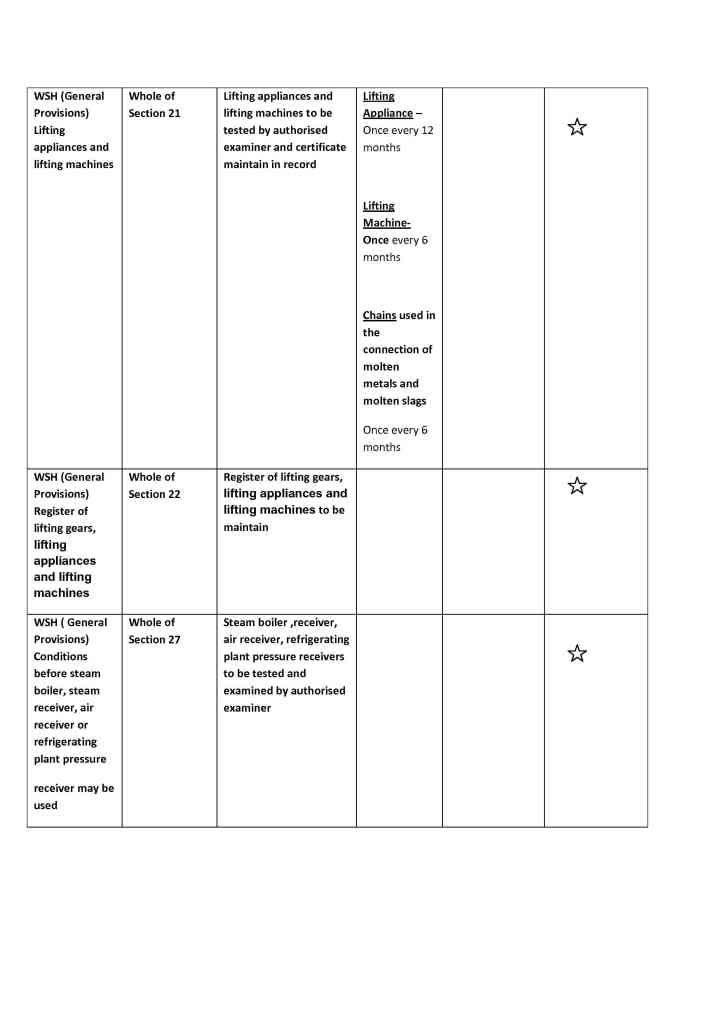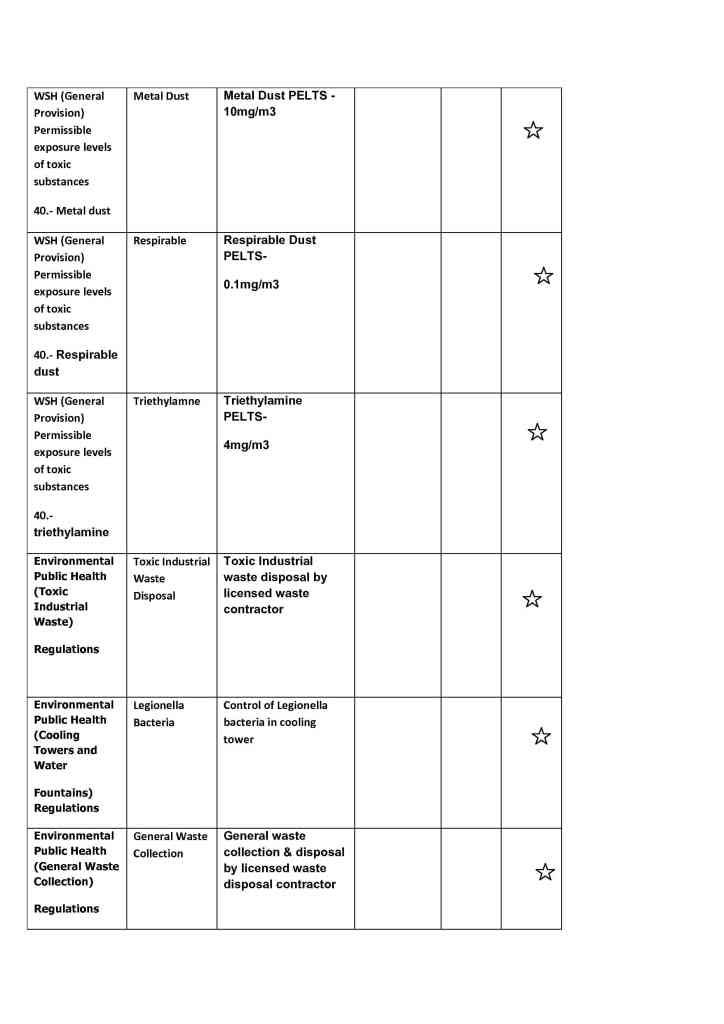Collect Information Relevant To Formulation Of WSH Policy
An organization that monitors it’s WSH performance and the changes of WSH legislation in the country in which it operates will usually have better WSH management and control as well as improved safety performance as opposed to those organization that do not monitor it’s HSE performanceThe availability of relevant organizational information provides the opportunity for the development of effective WSH policies which will results in better control of workplace hazards and risks as the implemented
WSH policies provides the principles in which the employees shall conduct their business, provide rooms for improvement as areas where remedial action is required are identified and it also creates the opportunity for feedback and motivation
Relevant organization information for the WSH Policy formulation may include but not restricted to the following:
• Audit results ( both internal audits & external audits)
• WSH performance indicators ( both proactive & reactive indicators)
• Management Reviews
• WSH risk assessments
• Legal ad other requirements
• Relevant social and economical factors
Risk Management
Substantial amount of WSH information were gathered from the plant risk assessment exercise which is very useful for the formulation of the WSH Policies because the workplace hazards were identified and risks evaluated and decision prioritized to reduce risks to tolerable level based on collective cross functional teams effort’s using a structured and systematic procedure.
External Audit
Results from an audit can be consider as relevant organization information because it constitutes the “feedback loop” to the planning stage which enables an organization to reinforce, maintain and develop it’s ability to reduce risks to reduce risks to the fullest extent and to ensure the continued efficiency, effectiveness and reliability of the WSH management system
Survey
Organization can undertake survey to gather feedback & opinions from their stakeholders
Survey
Organization can undertake survey to gather feedback & opinions from their stakeholders
Question 1 : Management Are Committed To Health Of Employees
Total no. of answers =21,980 | |||||||
Average | 5.88% | 5.88% | 5.88% | 17.65% | 29.41% | 35.29% | |
Subtotal | 1,275 | 1,275 | 1,275 | 3,879 | 6,464 | 7,757 | 0 |
Highly disagree | Moderately disagree | Slightly disagree | Slightly agree | Moderately agree | Highly agree | Not applicable to me | |
35.29% of workforce –highly agree management are committed to Health of Employees
5.88% of workforce-highly disagree management are committed to Health of Employees
5.88% of workforce-highly disagree management are committed to Health of Employees
Conclusion: It is evident that a fraction of the workforce are not satisfied with the existing health programmes institutionalized by the organization. The organization have to conduct employee health needs and develop suitable health programmes
Question 2 : Management Always Improves the work environment to minimize employees health impact
Total no. of answers=21,980 | |||||||
Average | 0.00% | 6.25% | 18.75% | 18.75% | 18.75% | 37.50% | 0.00% |
Subtotal | 0 | 1,374 | 4,121 | 4,121 | 4,121 | 8,243 | 0 |
Highly disagree | Moderately disagree | Slightly disagree | Slightly agree | Moderately agree | Highly agree | Not applicable to me | |
37.50% of workforce –highly agree management always improves the work environment to minimize employees health impact
6.25 % workforce-moderately disagree management always improves the work environment to minimize employees health impact
Conclusion: It is evident from the survey , a small percentage of the workforce does not agree with the notion that the management always improves the work environment to minimize employees heath impact. Clearly the organization have to conduct employee health needs analysis to establish
Question 3 : The Workforce Is Committed To Prevent The Spread Of H5N1
Total no. of answers=21,980 | |||||||
Average | 0.00% | 8.33% | 16.67% | 8.33% | 33.33% | 33.33% | 0.00% |
Subtotal | 0 | 1,831 | 3,664 | 1,831 | 7,326 | 7,326 | 0 |
Highly disagree | Moderately disagree | Slightly disagree | Slightly agree | Moderately agree | Highly agree | Not applicable to me | |
33.33% of workforce –highly agree that the workforce is committed to prevent the spread of H5N1
Infectious Disease
Infectious Disease
8.33 % workforce-moderately disagree that the workforce is committed to prevent the spread of H5N1 Infectious Disease
Conclusion: It is evident from the survey that small fraction of the workforce moderately disagree that workforce is committed to prevent the spread of H5N1.And the data indirectly tells us there are 2 different school of thoughts in the shop floor
Question 4 : Our Job Is Very hazardous To Our HealthTotal no. of answers=21,980 | |||||||
Average | 47.06% | 17.65% | 5.88% | 11.76% | 5.88% | 11.76% | 0.00% |
Subtotal | 10,344 | 3,879 | 1,292 | 2,585 | 1,292 | 2,585 | 0 |
Highly disagree | Moderately disagree | Slightly disagree | Slightly agree | Moderately agree | Highly agree | Not applicable to me | |
47.06% of workforce –highly disagree that the their job is very hazardous to their health
11.76 % workforce-highly agree that their job is very hazardous to their health
11.76 % workforce-highly agree that their job is very hazardous to their health
Conclusion: It is evident from the survey that 11.76% of the workforce highly agree that their job is very hazardous to their health and this indirectly tells us either the risk assessment is not properly conducted or the implemented control measures are not effective to mitigate the severity of the hazards
Question 5 : Productivity Comes Before Health
Total no. of answers=21,980 | |||||||
Average | 6.11% | 16.67% | 5.56% | 5.00% | 27.78% | 38.89% | 0.00% |
Subtotal | 1,343 | 3,664 | 1,222 | 1,099 | 6,106 | 8,548 | 0 |
Highly disagree | Moderately disagree | Slightly disagree | Slightly agree | Moderately agree | Highly agree | Not applicable to me | |
38.89% of workforce –highly agree productivity comes before health
6.11 % workforce-highly disagree that productivity should come before health
Conclusion: It is evident from the survey conducted that the organization safety culture needs improvement as a high fraction of the workforce 38.89% are risk takers who are willing to take risk just to fulfil high productivity rate
Question 6 : Are Accidents Caused By Unsafe Workers
Total no. of answers=21,980 | |||||||
Average | 6.11% | 16.67% | 5.56% | 5.00% | 27.78% | 38.89% | 0.00% |
Subtotal | 1,343 | 3,664 | 1,222 | 1,099 | 6,106 | 8,548 | 0 |
Highly disagree | Moderately disagree | Slightly disagree | Slightly agree | Moderately agree | Highly agree | Not applicable to me | |
38.89% of workforce –highly agree that accidents are caused by unsafe workers
6.11 % workforce-highly disagree that accidents are caused by unsafe workers
Conclusion: It is evident from the survey conducted that accidents are not purely contributed by the unsafe acts of workers as a small fraction of the workforce 6.11% suggested there are other underlying factors too. Based on this findings, it is necessary to conduct risk assessment on all activities championed by cross-functional risk assessment team
Question 7 : Safety Communications On H5N1 Are Effective
23.81% of workforce –highly agree that safety H5N1 communications are effective
4.76% workforce-highly disagree that the organization safety H5N1 communications are effective
4.76% workforce-highly disagree that the organization safety H5N1 communications are effective
Total no. of answers=21,980 | |||||||
Average | 4.76% | 14.29% | 9.52% | 19.05% | 28.57% | 23.81% | 0.00% |
Subtotal | 1,046 | 3,141 | 2,093 | 4,187 | 6,280 | 5,233 | 0 |
Highly disagree | Moderately disagree | Slightly disagree | Slightly agree | Moderately agree | Highly agree | Not applicable to me | |
Conclusion: It is evident from the survey conducted that the safety communication on H5N1 needs improvement as 4.76% of the workforce highly disagree that the communication on H5N1 is effective.
Question 8 : Our H5N1 Emergency Procedures Are Effective
45.45% of workforce –highly agree that the workforce H5N1 Emergency Procedures Are Effective
3.09 % workforce-highly disagree that the workforce H5N1 Emergency Procedures Are Effective
Conclusion: It is evident from the survey conducted that organization needs to improve on its H5N1 emergency procedures as a fraction of the workforce disagree that the H5N1 emergency procedures are effective
Total no. of answers=21,980 | |||||||
Average | 3.09% | 6.00% | 9.09% | 9.09% | 27.27% | 45.45% | 0.00% |
Subtotal | 679 | 1,319 | 1,998 | 1,998 | 5,994 | 9,990 | 1 |
Highly disagree | Moderately disagree | Slightly disagree | Slightly agree | Moderately agree | Highly agree | Not applicable to me | |
Question 9 : Our H5N1 Safety Training Is Effective
41.67% of workforce –highly agree that the organization H5N1 Safety Training is effective
3.97 % workforce-highly disagree that the organization H5N1 Safety Training is effective
3.97 % workforce-highly disagree that the organization H5N1 Safety Training is effective
Conclusion: It is evident from the survey conducted that the organization needs to conduct further employees training needs analysis to identify what are the trainings applicable to it’s context as a fraction of the workforce 3.97% highly disagree that the organization H5N1 Safety Training is effective
Total no. of answers=21,980 | |||||||
Average | 3.97% | 6.00% | 9.09% | 9.09% | 27.27% | 41.67% | 0.00% |
Subtotal | 679 | 1,319 | 1,998 | 1,998 | 5,994 | 9,990 | 1 |
Highly disagree | Moderately disagree | Slightly disagree | Slightly agree | Moderately agree | Highly agree | Not applicable to me | |
Question 10 : Our H5N1 Implemented Control Measures Are Effective
33.33% of workforce –highly agree that the workforce H5N1 implemented control measures are effective
8.33 % workforce-moderately disagree that the workforce H5N1 implemented control measures are effective
Conclusion: It is evident from the survey conducted that small fraction of the work force highly disagree that the organization H5N1 implemented control measures are effective
Total no. of answers=21,980 | |||||||
Average | 8.33% | 8.33% | 16.67% | 16.67% | 16.67% | 33.33% | 0.00% |
Subtotal | 1,831 | 1,831 | 3,664 | 3,664 | 3,664 | 7,326 | 0 |
Highly disagree | Moderately disagree | Slightly disagree | Slightly agree | Moderately agree | Highly agree | Not applicable to me | |
Feedback From Stake Holders
Gathering the feed back or opinions from the organization stake holders are important because it creates the opportunity to expose stake holders to the organizations current vision of the system and to engage them in the formulation of WSH Policy. In addition, stake holder feed back and opinions
can be used by an organization to determine the implications for the formulation of it’s WSH policy






















